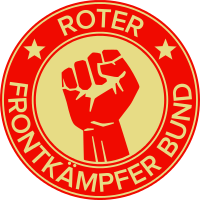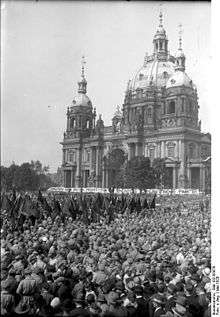Roter Frontkämpferbund
Roter Frontkämpferbund | |
|---|---|
 | |
| Leader | |
| Founded | July 1924 |
| Dissolved | May 1929 |
| Newspaper | Rote Front |
| Youth wing | Rote Jungfront |
| Membership | 130,000 by 1929 |
| Political position | Far-left |
The Roter Frontkämpferbund (German: [ˈʁoːtɐ ˈfʁɔntˌkɛmpfɐbʊnt], "Alliance of Red Front-Fighters"), usually called Rotfrontkämpferbund, abbreviated RFB, was officially a non-partisan and legally registered association, but in practice a paramilitary organization under the leadership of the Communist Party of Germany (German: Kommunistische Partei Deutschlands, KPD) during the Weimar Republic.
The first local groups of the RFB were established in July 1924. The first nationwide meeting was held in February 1925 in Berlin; Ernst Thälmann was elected the first leader of the federal committee. Die Rote Front ('The Red Front') was the newspaper of the RFB. The greeting of „Rot Front!“ (English: Red Front!) while rising a clenched fist gave rise to the expression Rotfront, often used among friends and foes to refer to the organization instead of its full title. The clenched fist "protecting the friend, fighting off the enemy" (German: „schützend den Freund, abwehrend den Feind“) was the symbol of the RFB, used on all its insignias, and its registered trademark since March 1, 1926. In May 1926, during a flag parade, activists used it as a sign of rallying to the movement and as an oath to defend the USSR.
History
Formation
The KPD depended on the Proletarian Hundreds (German: Proletarische Hundertschaften) to protect their meetings and demonstrations, but this organization wase banned in 1923. This left the KPD's political activities exposed to attacks from the police and right-wing paramilitary organizations such as the Stahlhelm and the Nazi Sturmabteilung (SA).[1] The ninth national conference of the KPD in April 1924 decided to form a new defense organization. It was given the name Roter Frontkämpfer-Bund, with the intent of attracting non-Communist workers as well.
Then in Halle on May 11, 1924, police fired on a demonstration; eight workers were killed and 16 seriously wounded. The KPD announced the formation of the RFB to all its local branches, and soon the first local RFB groups were formed. Most of these first RFB units were located in industrial cities, seaports, and other traditional strongholds of the working class.

Development
Over the years the RFB engaged more and more in violent street fights with the police, the SA, and other political rivals. In 1929, the RFB participated in bloody protests after International Workers' Day was banned in Berlin. More than 30 people were shot and killed by the police. The RFB was banned and all its assets confiscated by the government. At the time of the ban, the RFB had close to 130,000 members. Many of them continued their activities illegally or in local successor organizations such as the Kampfbund gegen den Faschismus. (English: Fighting-Alliance Against Fascism) Others retired from the political scene. Later historians claimed that RFB members often joined the ranks of the SA. However, that is disputed.[2]
Under the Third Reich
After the Nazi takeover in 1933, former RFB members were among the first arrested and incarcerated in concentration camps. The Nazis sought revenge on their former rivals and many of the RFB died in the Nazi prisons.
Of those who survived or avoided arrest, many followed the call of the Second Spanish Republic during the Spanish Civil War (1936–39). They joined the Centuria Thälmann of the International Brigades to fight against the "Nationalist" rebels. During World War II former Red Front fighters fought in the Soviet Red Army against Nazi Germany.
After the war
After World War II, former RFB members such as Erich Honecker and Erich Mielke were actively involved in the creation of the first police and military units of the German Democratic Republic (GDR; East Germany). The Arbeiterkampfgruppen (English: Combat Groups of the Working Class) and the Nationale Volksarmee (English: National People's Army) claimed to carry on the traditions of the RFB, while the Federal Republic of Germany in West Germany enforced the ban of 1929 and prosecuted former Red Front fighters who admitted to their RFB activities.
Membership and organisation
Members
While many RFB groups were led by KPD members, most Red Front fighters were not party members. Some were even members of the Social Democratic Party of Germany (SDP) or other political organizations.
98% of the RFB belonged to the working class and only 1% had received a higher education. A large part of the RFB were veterans of World War I and some had been actively involved in the November Revolution of 1918.
The number of members grew constantly, peaking with close to 130,000 members at the time of the ban in 1929.
- April 1925: 40,450 members in 558 local groups (49% non-party members)
- June 1925: 51,630 members in 826 local groups (53% non-party members)
- February 1926: 68,392 members in 1,120 local groups (55% non-party members)
At the time of the ban in 1929, only 30% of the RFB were actually KPD members. 70% were non-party or members of other parties.
Sections
For its younger members (between the ages of 16 and 21), the RFB formed the Roter Jungsturm (English: Red Young Storm). It was renamed Rote Jungfront (RJ) (English: Red Young Front) in 1925 to avoid similarities with the Nazi Jungsturm and to underline their goal of a united front. 40% of local RFB groups had a section of the RJ.
Sailors of the Imperial German Navy had a major role in the November Revolution of 1918. To commemorate this, in May 1925 the RFB founded the Rote Marine (RM) (English: Red Navy) with sections in all major port cities. The RM was also considered an elite unit.
Since 1925 the female members were organized in the Roter Frauen und Mädchen Bund (RFMB) (English: Alliance of Red Women and Girls). The federal leader was Clara Zetkin, and at the 1929 ban, the RFMB had about 4,000 members.
Organizational structure
The RFB's structure was a bottom to top organization. The local groups elected the regional leadership and the regional leaders elected the federal committee.
- 1. Bundesführung (English: Federal Committee)
- 2. Gauführung (English: Regional Committee)
- 3. Ortsgruppe (X Abteilungen, English: Local Group (with several battalions, depending on the member strength of the local group))
- 3.1. Abteilung (X Kameradschaften, English: Battalion made up of X "Comradeships")
- 3.2. Kameradschaft (3 Züge, c. 100 men, English: Comradeship made up of 3 Platoons, approx. 100 men)
- 3.3. Zug (4 Gruppen, c. 35 men + 1 Zugführer, English: Platoon made up of 4 Groups, approx. 35 men plus 1 platoon leader)
- 3.4. Gruppe (8 men + 1 Gruppenführer, English: Group made up of 8 men plus 1 group leader)
Bundesführung
The Bundesführung or "Federal Committee" included:
- Ernst Thälmann (1. Federal Leader)
- Willy Leow (2. Federal Leader, Organizational and Technical Manager)
- Alfred Oelßner (Treasurer)
- Ernst Schneller
- Hans Jendretzky
- Fritz Selbmann
- Werner Jurr
- Albert Schreiner (Chief Editor Rote Front)
- Curt Steinbrecher
RFB-Gaue
The RFB-Gaue or Regional sections of the RFB included:
- Wasserkante
- Thüringen (Thuringia)
- Berlin-Brandenburg
- Magdeburg-Anhalt
- Halle-Merseburg
- Niedersachsen (Lower Saxony)
- Nordwest (Northwest)
- Ruhrgebiet (Ruhr district)
- Niederrhein (Lower Rhine)
- Mittelrhein (Middle Rhine)
- Hessen-Waldeck (Hesse-Waldeck)
- Hessen-Frankfurt (Hesse-Frankfurt)
- Saargebiet (Saar district)
- Baden
- Württemberg
- Pommern (Pomerania)
- Ostpreußen (East Prussia)
- Oberschlesien (Upper Silesia)
- Schlesien (Silesia)
- Erzgebirge-Vogtland
- Mecklenburg
- Ostsachsen (East Saxony)
- Westsachsen (West Saxony)
- Nord-Bayern (North Bavaria)
- Süd-Bayern (South Bavaria)
Plans to form local RFB groups in the cities of Nuremberg and Munich in 1925 were banned by the state of Bavaria. Until 1928 there were no official RFB groups in Bavaria.
Activities
"Protection and Security"
A large part of the RFB activities were directed at supporting the political propaganda work of the KPD, the Rote Hilfe (English: Red Help), and other "proletarian" organizations such as workers unions. In most cases they provided security services for the various events but also participated in active agitation. Hardened by their harsh work and living conditions, the RFB men engaged in acts of violence against the police and the political rivals who tried to disrupt rallies.
Numerous events ended in mass brawls between the police and the RFB, leaving injured on both sides and in some cases dead.
Arrested RFB members could depend on the Rote Hilf for legal support and also, in case of sentencing to prison, for financial support of their families while they were unable to work.
Until the RFB was banned, its rivalry with hostile organizations such as the SA, the Stahlhelm, and the Reichsbanner grew constantly and violence intensified. Since the strategy of the SA was to fight and provoke, violent encounters between the RFB and SA soon became a part of everyday life. The SA achieved some strength in working-class districts, although these areas supported either the SPD or the KPD but not the "brown" Nazi Party the SA stood for.
The RFB members also fought to stop landlords from evicting tenants.
"Social Justice and Peace"
Its statutes defined the RFB as anti-militarist, and therefore it opposed German re-armament. For instance, the RFB and other organizations for instance protested against the spending of billions of Reichsmarks on "pocket battleships", and demanded the money go instead to relieve poverty.
Most RFB public actions were directed against the Weimar government and its involvement with powerful German industrialists. The RFB demanded the preservation of peace and denounced plans for a new war. Most of the RFB also supported the KPD's program of Soviet-style Communism. The RFB therefore was soon considered an "enemy of the state", leading to several temporary bans of its announced parades and meetings.
Other RFB events included propaganda marches in rural areas to get poor farmers and agricultural workers to join their cause.
References
| Wikimedia Commons has media related to Roter Frontkämpferbund. |
